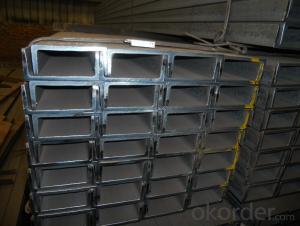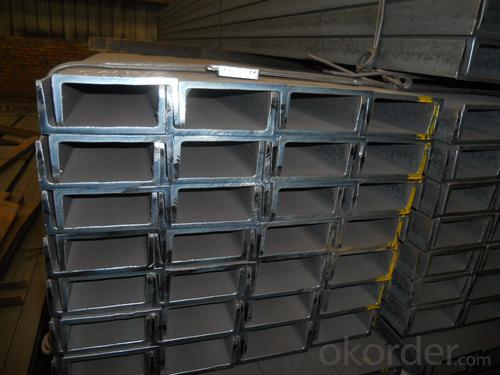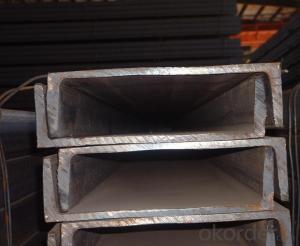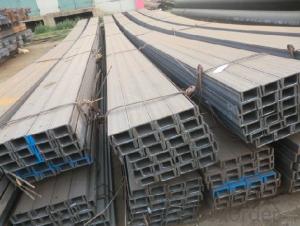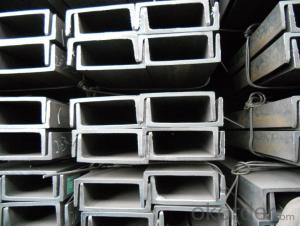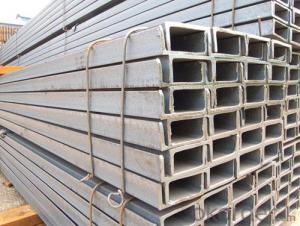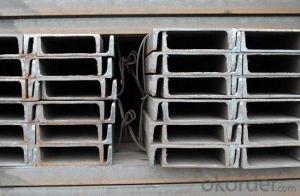Steel Channel 100-125mm
- Loading Port:
- China Main Port
- Payment Terms:
- TT OR LC
- Min Order Qty:
- -
- Supply Capability:
- -
OKorder Service Pledge
OKorder Financial Service
You Might Also Like
Specifications of JIS Channel Steel:
1. We are definitely speciallizing in manufacturing and supplying channel steel as per japanese standard, which is characterised with high mechanical strength and competitive prices.
| Standard | JIS G3192 |
| Material Grade | SS400 |
| Sizes | 50mm to 200mm |
| Sales Volume/Year | 3000MT |
| Destination Area | Middle East, Africa, Southeast Asia |
Size and Mass:
| Size (mm) | Mass (Kg/m) | Size (mm) | Mass (Kg/m) |
| 100*50*3.8 | 7.30 | 100*50*5.0 | 9.36 |
| 100*50*4.5 | 8.97 | 125*65*5.2 | 11.66 |
The mechanical property of JIS Channel Steel:
Grade | Yield Strength,N/mm² | Extension Strength N/mm² | |||
Thickness of Steel,mm | |||||
≦16 | >16-≦40 | >40-≦100 | >100 | ||
SS400 | ≧245 | ≧235 | ≧215 | ≧205 | 400-510 |
Package & Delivery of JIS Channel Steel:
1.The channel steel will be packed in bundle with steel wire at each end of every bundle and color marking in order to help the customer to recognize his goods more easily at sight.
2. And the channel steel could be loaded into 20ft or 40ft container, or by bulk cargo.If the weight of each bundle reaches more than 3.5 mt, the loading by break bulk cargo should be choosed.When the weight of each bundle reaches less than 3mt, the loading by container should be choosed.
3.As for the transportaion from mill to loading port, the truck will be usually used. And the maximum quantity for each truck is 40mt.
4.All in all, we could do in accordance with customer's request.
*If you would like to get our price, please inform us the size, standard/material and quantity. Thank you very much for your attention.
- Q: What about the specification of channel steel?
- Channel steel is a strip of steel with a cross section. The specifications are expressed in millimeters of height (H) * leg width (b) * waist thickness (d), such as 120*53*5, which means waist height is 120 mm, leg width is 53 mm, waist thickness is 5 mm channel, or 12# channel steel. The same height of the channel, if there are several different leg width and waist thickness, also need to add a, B, C on the right side of the model to distinguish, such as 25a#, 25b#, 25c# and so on.
- Q: What are the considerations for designing steel channel connections?
- When designing steel channel connections, there are several key considerations that must be taken into account to ensure the structural integrity and safety of the overall system. These considerations include: 1. Load capacity: The connection design should be able to withstand the expected loads and forces that will act on the steel channels. This includes both static and dynamic loads, such as dead loads, live loads, wind loads, and seismic loads. 2. Connection type: There are various types of connections that can be used for steel channels, such as bolted connections, welded connections, or a combination of both. The type of connection chosen should be based on factors such as the expected loads, ease of installation, maintenance requirements, and cost-effectiveness. 3. Strength and stiffness: The connection design should provide adequate strength and stiffness to resist the applied loads without excessive deflection or deformation. This involves considering the material properties of the steel channels, such as yield strength, ultimate strength, and modulus of elasticity, as well as the connection details and geometry. 4. Fatigue resistance: If the steel channels are subjected to cyclic or repeated loading, such as in bridges or machinery, the connection design should be able to resist fatigue failure. This may require incorporating features such as fillet welds, reinforcement plates, or special detailing to enhance the fatigue strength of the connection. 5. Alignment and fit-up: Proper alignment and fit-up of the steel channels at the connection points are critical for ensuring a secure and effective connection. The connection design should account for any potential misalignments or tolerances in the fabrication and erection process, and provide means for adjustment or correction if needed. 6. Serviceability and maintenance: The connection design should consider the long-term performance and durability of the connection. This includes factors such as corrosion protection, accessibility for inspection and maintenance, and the potential for future modifications or repairs. 7. Code compliance: The connection design should comply with relevant building codes, standards, and regulations. It is important to consider the requirements and guidelines specified by national or international codes, as well as any specific design criteria or recommendations from structural engineering associations. Overall, designing steel channel connections requires a thorough understanding of the mechanical behavior of steel, as well as the specific loading conditions and performance requirements. By considering these factors and utilizing appropriate design methods and principles, engineers can ensure the reliability and safety of steel channel connections in various structural applications.
- Q: Can steel channels be used for solar panel racking systems?
- Indeed, solar panel racking systems can make use of steel channels. These channels are frequently employed in the construction field owing to their robustness, longevity, and adaptability. They establish a solid structure for the attachment and reinforcement of solar panels, guaranteeing their secure positioning. Moreover, steel channels can be readily tailored and manufactured to meet particular project prerequisites, rendering them fitting for diverse solar panel installation designs.
- Q: What are the different types of coatings available for steel channels?
- There are several different types of coatings available for steel channels, each offering unique benefits and properties. Some of the most common types of coatings include: 1. Galvanized Coating: This is one of the most popular and widely used coatings for steel channels. Galvanizing involves applying a layer of zinc to the surface of the steel, providing excellent corrosion resistance. This coating is durable, long-lasting, and protects the steel from rusting and other environmental damage. 2. Powder Coating: Powder coating is a dry finishing process where a powdered polymer is applied to the steel channel and then heated to form a protective layer. This type of coating offers excellent durability, chip resistance, and aesthetic appeal. Powder coating can be customized in various colors, making it ideal for decorative applications. 3. Epoxy Coating: Epoxy coatings are highly resistant to chemicals, moisture, and abrasion. They are commonly used in industrial and marine applications where the steel channels are exposed to harsh environments. Epoxy coatings provide excellent protection against corrosion and can also improve the overall appearance of the steel. 4. Paint Coating: Paint coatings are widely used on steel channels for both functional and decorative purposes. They provide a smooth and aesthetically pleasing finish while also offering some level of corrosion protection. Depending on the requirements, different types of paints, such as acrylic, enamel, or urethane, can be used for coating steel channels. 5. Anodizing: Anodizing is a process that involves creating an oxide layer on the surface of the steel channel. This coating provides enhanced corrosion resistance and can also improve the durability of the steel. Anodized coatings are commonly used in architectural applications where the steel channels are exposed to outdoor elements. It is important to consider the specific requirements of the steel channel and the intended application when choosing the appropriate coating. Factors such as environmental conditions, desired lifespan, and aesthetics should all be taken into account to select the most suitable coating for steel channels.
- Q: What are the factors to consider when determining the appropriate angle of a steel channel?
- There are several factors to consider when determining the appropriate angle of a steel channel. Firstly, one must take into account the intended purpose or function of the steel channel. Different applications may require different angles. For instance, if the channel is being used as a support or brace, a larger angle may be necessary to ensure sufficient strength and stability. Conversely, if the channel is being used for aesthetic purposes or to create a specific shape, a smaller angle may be more suitable. Secondly, the load that the steel channel will be subjected to is a crucial factor in determining the angle. It is necessary to analyze the weight and distribution of the load to ensure that the chosen angle can withstand the forces and stresses exerted on it. This involves considering factors such as the magnitude and direction of the load, as well as any potential dynamic or impact forces that may be present. Additionally, the material properties of the steel channel should be taken into consideration. Different types of steel have varying strength, durability, and flexibility characteristics. The appropriate angle will depend on the specific properties of the steel being used, as well as any relevant industry standards or regulations. Furthermore, one must consider the fabrication and installation process. The chosen angle should be feasible to manufacture and install, taking into account factors such as cutting, welding, and assembly techniques. It is important to ensure that the angle selected can be easily achieved within the available resources and capabilities. Lastly, cost considerations should not be ignored. Different angles may require varying amounts of steel and fabrication efforts, resulting in different costs. It is essential to balance the desired angle with the available budget in order to make an informed decision. In conclusion, the factors to consider when determining the appropriate angle of a steel channel include the intended purpose, load requirements, material properties, fabrication and installation feasibility, and cost considerations. Taking all these factors into account will help ensure that the selected angle is suitable for the specific application and provides the necessary strength and functionality.
- Q: Are steel channels suitable for industrial applications?
- Yes, steel channels are suitable for industrial applications due to their strength, durability, and versatility. They can be used in various industrial settings such as construction, manufacturing, and infrastructure projects, providing structural support, framework, and reinforcement. Steel channels offer excellent load-bearing capacity, resistance to corrosion, and the ability to withstand high temperatures, making them reliable and cost-effective choices for industrial applications.
- Q: Can steel channels be used for creating partitions or dividers?
- Yes, steel channels can be used for creating partitions or dividers. They provide structural support and can be easily installed to create separate spaces within a larger area. Steel channels offer durability and strength, making them suitable for dividing spaces in various settings such as industrial facilities, warehouses, offices, and residential spaces.
- Q: Can steel channels be customized to specific dimensions?
- Yes, steel channels can be customized to specific dimensions. Steel channels are versatile and can be fabricated to meet specific requirements in terms of width, height, and thickness. This customization is achieved through various manufacturing processes like cutting, bending, and welding. By altering these dimensions, steel channels can be tailored to fit specific applications and structural requirements. Whether it is for construction, machinery, or any other industry, steel channels can be customized to meet the desired dimensions and specifications.
- Q: How do steel channels contribute to LEED certification?
- Steel channels can contribute to LEED (Leadership in Energy and Environmental Design) certification in several ways. Firstly, steel is a highly sustainable material as it is recyclable and can be used in multiple construction projects, reducing the demand for new materials. This aspect aligns with the LEED principle of minimizing waste and promoting resource efficiency. Additionally, steel channels can be manufactured with a high percentage of recycled content, which can earn points towards LEED certification under the Materials and Resources category. Using recycled steel channels reduces the need for extracting and processing raw materials, resulting in a lower carbon footprint and reduced environmental impact. Steel channels can also contribute to energy efficiency in buildings. Steel has excellent thermal conductivity, which allows it to efficiently conduct heat. This property can be utilized in building designs to enhance the overall energy performance of the structure. For example, steel channels can be used in radiant heating and cooling systems, improving energy efficiency and reducing the reliance on traditional HVAC systems. Furthermore, steel channels can provide structural integrity to buildings, ensuring long-term durability and resilience. This durability reduces the need for frequent repairs or replacements, which can contribute to a lower environmental impact and reduced waste generation over the building's lifecycle. In conclusion, steel channels contribute to LEED certification by offering sustainable attributes such as recyclability, high recycled content, energy efficiency, and long-term durability. By incorporating steel channels into construction projects, builders and designers can contribute to a greener and more sustainable built environment, aligning with the goals and principles of LEED certification.
- Q: How do steel channels compare to other structural shapes like beams and angles?
- Due to their strength, versatility, and cost-effectiveness, steel channels, beams, and angles find widespread use in construction and structural engineering. Each of these structural shapes possesses unique characteristics and applications, rendering them suitable for various purposes. When comparing steel channels to beams and angles, it becomes crucial to take into account their load-bearing capacity, structural stability, and overall performance. Steel channels, also known as C-channels or U-channels, exhibit a distinctive shape characterized by a vertical web connecting flat top and bottom flanges. They are commonly employed in applications necessitating lightweight structural support, such as framing, bracing, or object securing. Steel channels excel in evenly distributing loads and providing sufficient support in multiple directions. Their versatility allows for seamless integration into diverse structural designs. On the other hand, beams typically possess an I-shape and offer superior load-bearing capabilities compared to channels. Their design enables them to handle higher loads across longer spans. Beams typically serve as primary structural elements in buildings, bridges, and other large-scale constructions. Thanks to their high strength-to-weight ratio, beams are ideal for withstanding bending and flexural stresses. Angles, comprising two perpendicular legs of equal or unequal lengths, manifest as L-shaped structural components. They primarily serve the purpose of providing additional structural support and reinforcement. Angles commonly find use as braces, corner supports, or lintels. Their versatility allows for easy connections and integration within a structure. In terms of cost, steel channels are generally more affordable compared to beams and angles due to their simpler manufacturing process and lower material requirements. However, the cost may vary depending on the specific dimensions, grades, and finishes required. Overall, the choice between steel channels, beams, or angles depends on the specific application, load requirements, span lengths, and design constraints. It is crucial to consult with a structural engineer or designer to determine the most suitable structural shape for a particular project.
Send your message to us
Steel Channel 100-125mm
- Loading Port:
- China Main Port
- Payment Terms:
- TT OR LC
- Min Order Qty:
- -
- Supply Capability:
- -
OKorder Service Pledge
OKorder Financial Service
Similar products
Hot products
Hot Searches
Related keywords
